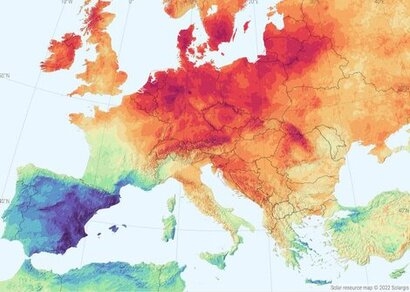
As extreme weather events continue to break records globally, 2022 saw Spain experience its largest decline in solar irradiance in 28 years after its wettest March in 61 years and a Saharan dust cloud that swept across the Mediterranean.
At the end of spring, a team of experts at solar data firm Solargis analysed their monthly difference maps to find a 50 percent decrease in Spanish solar irradiance – the most extreme decrease since the beginning of their satellite-based records in 1994. Contrastingly, Germany and the Balkans saw around 45 percent higher levels of solar irradiance during the month of March when compared to longer term averages.
It is essential that regional variability is better managed across regions of Europe by improving grid quality and interconnection.
With Spain one of Europe's sunniest countries and with Germany looking to triple its solar energy capacity to 215 GW, these significant deviations from average values pose a challenge to project developers and investors seeking to accurately calculate return on investment and support integration of solar into the continent’s grid. This is particularly significant at a time when policymakers are determined to slash the EU’s Russian oil and gas dependence by increasing adoption of renewables.
It is a well-known fact that grid interconnection in Europe isn’t currently sufficient to accommodate the growth in renewables required to reach climate targets. Insufficient interconnection hampers the ability of neighbouring solar and wind rich regions to compensate for anomalous conditions in markets such as Spain during the recent winter period.
Improved grids spanning countries will enable regional utility companies to compensate for localised variability through clean energy sources rather than reverting to fossil fuels.
While modernisation of the grid faces significant challenges, we are seeing a clear push for a more coordinated energy approach, including the recently formed SERENDI-PV – a project financed by the European Commission to investigate the reliable and dispatchable integration of PV (photovoltaics) into EU grids.
As a specialist in understanding solar as a resource, Solargis works closely with others in the project to highlight the variability challenge in key markets to best support policymakers, planners and consultants, encouraging a coordinated approach to interconnection between countries across Europe.
“While the power sources of our future require an innovative approach to grid interconnectivity, so too do they require increased digitalisation to support their integration” said Marcel Suri, CEO, Solargis. “A new generation of forecasting models allows grid operators to maintain balance between variable and flexible energy sources through flexible trading and energy exchange. The digitalisation of our grids coupled with increased interconnectivity ultimately will allow larger generators to react faster and more efficiently to regional variability of renewables. Controlling the weather is outside of our capabilities however, by looking at Europe as an interconnected, rather than country-specific, energy grid, there is the potential to balance out the market. Through our initiative with SERENDI-PV, we are working towards improving short-term forecasting of aggregated PV power, energy evaluation and forecasting in the presence of snow, dust and extreme weather, improving simulations, uncertainty reduction to support the creation of an effective, modern digitalised grid.”
For additional information:

